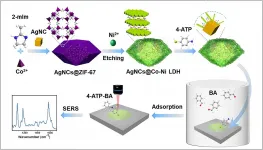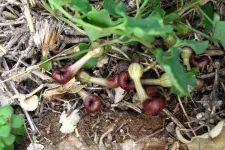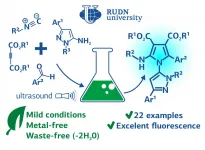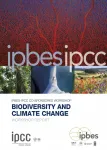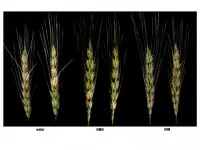(Press-News.org) Lack of water, floods, or crop losses: As a result of climate change, pronounced periods of drought and rainfall are occurring more frequently and more intensively all around the world, causing human suffering and major economic damage. The more precise seasonal forecasts for the coming months are, the more effectively these consequences can be mitigated. A research team from Karlsruhe Institute of Technology (KIT) has now been able to improve global forecasts using statistical methods so that they can be used on the regional level. The researchers describe the new approach and the economic benefits of seasonal forecasts in the journals Earth System Science Data and Scientific Reports.
One of the consequences of global warming relates to more frequent and more intense periods of drought or precipitation which are now causing major problems worldwide - for example in the supply of food, energy, or drinking water. Improved seasonal meteorological forecasts can be very helpful here: "If we are able to predict rainfall amounts and temperatures more accurately for the weeks and months to come, local decision makers can, e.g., more proactively plan and manage reservoirs or seed selection for the planting season. In this way, they can reduce damage and losses," says Professor Harald Kunstmann who works at the Institute of Meteorology and Climate Research - Atmospheric Environmental Research (IMK-IFU), KIT Campus Alpin, in Garmisch-Partenkirchen and at the University of Augsburg. Using statistical methods, he and his team have now been able to derive local forecasts from global climate models that are significantly more precise than the seasonal forecasts available to date. The researchers developed this method within the framework of an international project called "Seasonal Water Resource Management in Arid Regions" (SaWaM for short), which was funded by the German Federal Ministry of Education and Research (BMBF) and has now been completed.
Regionalized Global Forecasts with Local Relevance
Until now, only global climate models have been available in most cases when it comes to deliver regional forecasts over an average period of weeks or months. "For high-resolution seasonal forecasts, however, these models in their basic form are actually not suitable at all," explains Dr. Christof Lorenz from the Campus Alpin of KIT, who is a co-developer of the new method. The reasons for this are, among others, inconsistencies between forecasts that use different start times and deviations from climatological reference data due to model errors. "Thanks to the statistical correction and regionalization procedures we developed, we can now derive seasonal forecasts that are many times more accurate," says Lorenz. In the regions studied, such as Sudan, Ethiopia, Iran, northeastern Brazil, Ecuador, Peru, and West Africa, the new method enabled the researchers to predict abnormal heat and drought periods up to seven months in advance - with better results than ever before.
Thanks to their extreme precision for preparing seasonal forecasts, the new methods can now be put to practical use. "In particular, by providing early warning of wet or dry periods with an above-average extent, the improved forecast allows to initiate local measures to minimize damage in due time," explains Tanja Portele, a participating climate researcher who works at the Campus Alpin of KIT and at the University of Augsburg. The scientists were able to demonstrate the economic relevance of their approach by using climate data from several decades. "We've shown that seasonal drought forecasts when used in practice can save up to 70 percent of the costs, which would have been theoretically possible with a computationally determined best practice." For the large Upper Atbara Dam in Sudan, the scientists performed an exemplary quantification of the exact savings potential for a drought year. It amounts to $ 16 million.
KIT Methods in Use Worldwide
The new methods for more accurate seasonal forecasting are particularly important for semi-arid regions where the rainy season is limited to a few months of the year. "Here, the water usually has to be stored in reservoirs," Kunstmann says. "For its use, conflicting goals might arise between agriculture, the energy sector, and drinking water supply." Therefore, weather services and official institutions from Sudan and Iran have already adopted the new statistical methods from KIT in order to be able to base their local actions on sound knowledge. Moreover, even for regions that were rarely affected in the past, seasonal forecasts with higher precision are becoming increasingly relevant due to climate change. "So the method will also be used for drought forecasts in Germany in the future," the climate researcher adds.
INFORMATION:
Original publications
Portele, T., Lorenz, C., Dibrani, B., Laux, P., Bliefernicht, J., and Kunstmann, H. (2021) Seasonal Forecasts offer Economic Benefit for Hydrological Decision Making in Semi-Arid Regions, Scientific Reports,https://www.nature.com/articles/s41598-021-89564-y
Lorenz, C., Portele, T. C., Laux, P., and Kunstmann, H. (2021) Bias-corrected and spatially disaggregated seasonal forecasts: a long-term reference forecast product for the water sector in semi-arid regions, Earth Syst. Sci. Data,https://doi.org/10.5194/essd-2020-177
More information on the KIT Climate and Environment Center:https://www.klima-umwelt.kit.edu
Contact for this press release:
Martin Heidelberger, Press Officer, Phone: +49 721 608-41169, martin.heidelberger@kit.edu
Being "The Research University in the Helmholtz Association", KIT creates and imparts knowledge for the society and the environment. It is the objective to make significant contributions to the global challenges in the fields of energy, mobility, and information. For this, about 9,600 employees cooperate in a broad range of disciplines in natural sciences, engineering sciences, economics, and the humanities and social sciences. KIT prepares its 23,300 students for responsible tasks in society, industry, and science by offering research-based study programs. Innovation efforts at KIT build a bridge between important scientific findings and their application for the benefit of society, economic prosperity, and the preservation of our natural basis of life. KIT is one of the German universities of excellence.
Prof. HUANG Qing's group from the Hefei Institutes of Physical Science (HFIPS) developed a surface-enhanced Raman spectroscopy (SERS) gas sensor to detect aldehyde with high sensitivity and selectivity, which provided a new detection method for studying the adsorption of gas molecules on porous materials. The relevant research results have been published in Analytical Chemistry.
Adsorption technology is one of the main technologies for treating Volatile organic compounds (VOCs). Over the past years, metal-organic frameworks (MOFs) have attracted high interest for their outstanding adsorption property. Closely related to MOFs, layered double hydroxides (LDHs), also known as hydrotalcite-like ...
The annual number of new HIV infections among men who have sex with men (MSM) in England is likely to have fallen dramatically, from 2,770 in 2013 to 854 in 2018, showing elimination of HIV transmission by 2030 to be within reach - suggests work by researchers from the MRC Biostatistics Unit at the University of Cambridge and Public Health England (PHE), published in The Lancet HIV.
To manage the HIV epidemic among MSM in England, enhanced testing and earlier treatment strategies were scaled-up between 2011 and 2015 and supplemented from 2015 by pre-exposure prophylaxis (PrEP). The researchers examined the effect of these interventions on the number of new infections and investigated ...
Researchers have made progress towards a G7 commitment to establish safe standards for the release of antimicrobials into the environment, by developing a new framework that establishes safe thresholds.
The threat of bacteria developing resistance to antimicrobial drugs (often called antibiotics) used to treat infection is one of the greatest global health challenges, potentially resulting in 10 million deaths per year by 2050.
A major issue is the spread of antimicrobials and resistant bacteria through water systems. When we take antibiotics, 70 per cent passes through our bodies into wastewater. Farm animals are treated with antibiotics which ...
Plants use numerous mechanisms for their pollination. Now botanists have discovered a particularly sophisticated system among pipevines that is based purely on deception.
The flowers of the Greek plant Aristolochia microstoma emit a foul, musty scent that seems to mimic the smell of decaying insects. The fly pollinators from the genus Megaselia likely get attracted to this odor while searching for arthropod corpses to potentially mate over and lay their eggs. Then, when entering the tube of an Aristolochia flower, the flies are guided by downward-pointing hairs into a small chamber, which holds the female and male floral organs. Trapped inside, they deposit pollen they carry onto the stigma, before the stamens ripen and ...
It eventually became a Nobel prize-winning revolution when researchers first engineered CRISPR as a gene editing technology for bacterial, plant, animal and human cells. The potential of the technology is great and span from curing genetically disposed diseases to applications in agricultural and industrial biotechnology, but there are challenges.
One such challenge consists of selecting a so-called gRNA molecule which should be designed to guide the Cas9 protein to the right location in the DNA where it will make a cut in relation to the gene editing.
"Typically, there are multiple possible gRNAs and they are not all equally efficient. Therefore, ...
Using a new 3D printing process, University of Nottingham researchers have discovered how to tailor-make artificial body parts and other medical devices with built-in functionality that offers better shape and durability, while cutting the risk of bacterial infection at the same time.
Study lead, Dr Yinfeng He, from the Centre for Additive Manufacturing, said: "Most mass-produced medical devices fail to completely meet the unique and complex needs of their users. Similarly, single-material 3D printing methods have design limitations that cannot produce a bespoke device with multiple biological or mechanical functions.
"But for the first time, using a computer-aided, multi-material ...
RUDN and Shahid Beheshti University(SBU) chemist proposed an eco-friendly method for the synthesis of pyrrole and pyrazole derivatives with a wide range of applications in medicine: from antidepressants to anticancer. Moreover, the synthesized compounds possess interesting fluorescence features, and the bioactive scaffolds might attract great interest in the fields of clinical diagnostics and biomedical research in the future. The results are published in the Organic & Biomolecular Chemistry.
Heterocyclic compounds expose remarkable chemistry with significant applications in medicinal and organic chemistry, industry, and pharmaceutical. These compounds are widely ...
Wine grape growers in California and elsewhere face increasing labor costs and severe labor shortages, making it difficult to manage and harvest a vineyard while maintaining profitability. Growers are increasingly turning to machines for pruning, canopy management and harvesting, but how well these practices are executed can substantially affect yield and quality. A new review by researchers at the University of California, Davis, published in the journal Catalyst, provides guidelines for growers to make the best use of machines.
"Wine grape laborers have been virtually nonexistent. People don't want to work in vineyards anymore because it's remote, tough work," said Kaan Kurtural, professor of viticulture and enology and extension ...
BONN, 10 June - Unprecedented changes in climate and biodiversity, driven by human activities, have combined and increasingly threaten nature, human lives, livelihoods and well-being around the world. Biodiversity loss and climate change are both driven by human economic activities and mutually reinforce each other. Neither will be successfully resolved unless both are tackled together.
This is the message of a workshop report, published today by 50 of the world's leading biodiversity and climate experts.
The peer-reviewed workshop report is the product of a four-day virtual workshop between ...
Kanazawa, Japan - Fungal diseases in cereal crops cause major economic losses and also threaten human and livestock health, because some fungi produce powerful toxins that might enter the food chain. Farmers use fungicides to control crop diseases, such as wheat head blight. Although agrochemicals are rigorously tested for safety, there can be concerns over chemical residues in food.
Now, researchers at Kanazawa University, in collaboration with colleagues at Ehime University and Nagoya University, have shown that the natural substance nicotinamide (NIM - a vitamin found in food and used as a dietary supplement) can help stimulate ...

